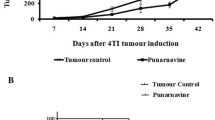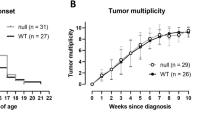Abstract
Background
Cyclo-oxygenase-2 (COX-2) is up-regulated in malignant tumours rendering it an attractive target for cancer therapeutics. However, whether long-term antagonism maintains its initial efficacy on established tumours is unclear.
Methods
4T1 cells were injected into the mammary fat pad of BALB/c mice (n = 8). Once tumour deposits were established, animals were randomized into two equal groups to receive either a selective COX-2 inhibitor (SC-236) or a drug vehicle. Further animals similarly treated (n = 7) were studied in diuresis cages allowing urine capture and analysis by mass spectrometry to determine Prostaglandin F-1 levels (PGF-1). In addition, both wild-type receiving SC-236 and COX-2 knockout mice receiving either SC 236 or vehicle were subjected to the same studies to determine whether tumour-derived or host-derived (stromal) COX-2 was the critical element. Finally, BALB/c mice with 4T1 tumours (n = 7) were treated with a combination of COX-2 and lipoxygenase (LOX) inhibition to attenuate this escape phenomenon.
Results
While selective COX-2 inhibition initially retarded tumour growth, a rapid increase in tumour growth rate occurred later (day 9). This escape phenomenon correlated with an increase in urinary PGF-1 levels. An identical trend was also observed whether COX-2 knockout mice received SC-236 or not, suggesting that this effect is due to increased tumour-derived COX-2 production rather than recovery of host COX-2 functional capacity. Finally, dual inhibition of COX and LOX pathways attenuated this escape process.
Conclusion
The anti-neoplastic effects of selective COX-2 inhibition may not be sustained as tumours demonstrate an escape capacity. However, this phenomenon maybe attenuated by a combination of COX/LOX inhibitors.




Similar content being viewed by others
References
Ristimaki A, Sivula A, Lundin J, Lundin M, Salminen T, Haglund C, Joensuu H, Isola J (2002) Prognostic significance of elevated cyclo-oxygenase-2 expression in breast cancer. Cancer Res 62(3):632–635
Kokawa A, Kondo H, Gotoda T, Ono H, Saito D, Nakadaira S, Kosuge T, Yosida S (2001) Increased expression of cyclooxygenase-2 in human pancreatic neoplasms and potential for chemoprevention by cyclooxygenase inhibitors. Cancer 91(2):333–338. doi:10.1002/1097-0142(20010115)91:2<333::AID-CNCR1006>3.0.CO;2-N
Sano H, Kawahito Y, Wilder RL, Hashiramoto A, Mukai S, Asai K, Kimura S, Kato H, Kondo M, Hla T (1995) Expression of cyclooxygenase-1 and 2 in human colorectal cancer. Cancer Res 55(17):3785–3789
Juo YE, Rew JS, Seo YH, Choi SK, Kim YJ, Park CS, Kim SJ (2003) Cyclooxygenase-2 overexpression correlates with vascular endothelial growth factor expression in tumour angiogenesis in gastric cancer. J Clin Gastroenterol 37(1):28–33. doi:10.1097/00004836-200307000-00009
Li W, Xu RJ, Zhang HH, Jiang LH (2006) Overexpression of cyclooxygenase-2 correlates with tumour angiogenesis in endometrial carcinoma. Int J Gynecol Cancer 16(4):1673–1678. doi:10.1111/j.1525-1438.2006.00408.x
Tjandrawinata RR, Dahiya R, Hughes-Fulford M (1997) Induction of cyclooxygenase-2 mRNA by prostaglandin E2 in human prostatic carcinoma cells. Br J Cancer 75(8):1111–1118
Pai R, Soreghan B, Szabo IL et al (2002) Prostaglandin E2 transactivates EGF receptor : a novel mechanism for promoting colon cancer growth and gastrointestinal hypertrophy. Nat Med 8:289–293. doi:10.1038/nm0302-289
Tsujii M, Kawano S, Tsuji S, Sawoaka H, Hori M, DuBois RN (1998) Cyclooxygenase regulates angiogenesis induced by colon cancer cells. Cell 93:705–716. doi:10.1016/S0092-8674(00)81433-6
Sharma S, Stolina M, Yang SC, Baratelli F, Lin JF, Atianzar K, Luo J, Zhu L, Lin Y, Huang M, Dohadwala M, Batra RK, Dubinett SM (2003) Tumour cyclooxygenase 2-dependent suppression of dendritic cell function. Clin Cancer Res 9:961–968
Li G, Yang T, Yan J (2002) Cyclooxygenase-2 increased the angiogenic and metastatic potential of tumour cells. Biochem Biophys Res Commun 299:886–890. doi:10.1016/S0006-291X(02)02707-9
Tsujii M, Kawano S, DuBois RN (1997) Cyclooxygenase-2 expression in human colon cancer cells increases metastatic potential. Proc Natl Acad Sci USA 94:3336–3340. doi:10.1073/pnas.94.7.3336
Romano M, Catalano A, Nutini M, D’Urbano E, Crescenzi C, Claria J, Libner R, Davi G, Procopio A (2001) 5-Lipoxygenase regulates malignant mesothelial cell survival: involvement of endothelial growth factor. FASEB J 15:2326–2336. doi:10.1096/fj.01-0150com
Cao Y, Pearmann AT, Zimmerman GA, McIntyre TM, Prescott SM (2000) Intracellular unesterified arachidonic acid signals apoptosis. Proc Natl Acad Sci USA 97:11280–11285. doi:10.1073/pnas.200367597
Connolly EM, Harmey JH, O’Grady T, Foley D, Roche-Nagle G, Kay E, Bouchier-Hayes DJ (2002) Cyclooxygenase inhibition reduces tumour growth and metastasis in an orthotopic model of breast cancer. Br J Cancer 87:231–237. doi:10.1038/sj.bjc.6600462
Roche-Nagle G, Connolly EM, Eng M, Bouchier-Hayes DJ, Harmey JH (2004) Antimetastatic activity of a cyclooxygenase-2 inhibitor. Br J Cancer 91(2):359–365
Kundu N, Fulton A (2002) Selective cyclooxygenase (cox)-1 or cox-2 inhibitors control metastatic disease in a murine model of breast cancer. Cancer Res 62:2343–2346
Hong SH, Avis I, Vos MD, Martinez A, Treston AM, Mulshine JL (1999) Relationship of arachidonic acid metabolizing enzyme expression in epithelial cancer cell lines to the growth effect of selective biochemical inhibitors. Cancer Res 59:2223–2228
Milas L, Kishi K, Hunter N, Mason K, Masferrer JL, Tofilon PJ (1999) Enhancement of tumour response to radiation by an inhibitor of cyclooxygenase-2 enzyme. J Natl Cancer Inst 91:1501–1504. doi:10.1093/jnci/91.17.1501
Tong WG, Ding XZ, Witt RC, Adrian TE (2002) Lipoxygenase inhibitors attenuate growth of human pancreatic xenografts and induce apoptosis through the mitochondrial pathway. Mol Cancer Ther 1:929–935
Pidgeon GP, Harmey JH, Kay E, Da Costa M, Redmond HP, Bouchier-Hayes DJ (1999) The role of endotoxin/lipopolysaccharide in surgically induced tumour growth in a murine model of metastatic disease. Br J Cancer 81(8):1311–1317. doi:10.1038/sj.bjc.6694369
Pulaski BA, Ostrand-Rosenberg S (2001) Mouse 4T1 breast tumour model. Curr Protoc Immunol. Chap 20: Unit 20.2
Thun MJ, Namboodiri MM, Calle EE, Flanders WD, Heath CW Jr (1993) Aspirin use and the risk of fatal cancer. Cancer Res 53:1322–1327
Chapple KS, Cartwright EJ, Howcroft G, Tisbury A, Bonifer C, Scott N, Windsor AC, Guillou PJ, Markham AF, Coletta PL, Hull MA (2000) Localization of cyclooxygenase-2 in human sporadic colorectal adenoma. Am J Pathol 156:545–553
Shattuck-Brandt RL, Varilet GW, Radhika A, Yang F, Washington MK, DuBois RN (2000) Cyclooxygenase-2 expression is increased in the subepithelial myofibroblasts of colon and caecal carcinoma from IL-10 (−/−) mice. Gastroenterology 118:337–345. doi:10.1016/S0016-5085(00)70216-2
Kinzler KW, Vogelstein B (1998) Landscaping the cancer terrain. Science 280:1036–1037. doi:10.1126/science.280.5366.1036
Williams CS, Tsujii M, Reese J, Dey SK, DuBois RN (2000) Host cyclooxygenase-2 modulates carcinoma growth. J Clin Invest 105(11):1589–1594. doi:10.1172/JCI9621
Hanahan D, Folkmann J (1996) Patterns and emerging mechanisms of the angiogenic switch during tumourigenesis. Cell 86:353–364. doi:10.1016/S0092-8674(00)80108-7
Abou-Issa HM, Alshafie GA, Seibert K, Koki AT, Masferrer JL, Harris JE (2001) Dose response effects of the COX-2 inhibitor, celecoxib, on the chemoprevention of mammary carcinogenesis. Anticancer Res 21:3425–3432
Jang TJ, Jung HG, Jung KH, O Min Ku (2002) Chemopreventive effect of celecoxib and expression of cyclooxygense-1 and cyclooygenase-2 on chemically induced rat tumour models. Int J Exp Pathol 83:173–182. doi:10.1046/j.1365-2613.2002.00228.x
Sheng H, Shao J, Kirkland SC, Isakson P, Coffey RJ, Morrow J, Beauchamp RD, DuBois RN (1997) Inhibition of human colon cancer cell growth by selective inhibition of cyclooxygenase-2. J Clin Invest 99:2254–2259. doi:10.1172/JCI119400
Alshafie GA, Abou-Issa HM, Seibert K, Harris RE (2000) Chemotherapeutic evaluation of celecoxib, a cyclooxygenase-2 inhibitor, in a rat mammary tumour model. Oncol Rep 7:1377–1381
Reddy BS, Maruyama H, Kelloff G (1987) Dose related inhibition of colon carcinogenesis by dietary piroxicam; a nonsteroidal anti-inflammatory drug, during different stages of rat colon tumour development. Cancer Res 47:5340–5346
Oshima M, Dinchuk JE, Kargman SL, Oshima H, Hancock B, Kwong E, Trasaskos JM, Evans JF, Taketo MM (1996) Suppression of intestinal polyposis in APC delta 716 knockout mice by inhibition of cyclooxygenase-2 (COX-2). Cell 87:803–809. doi:10.1016/S0092-8674(00)81988-1
Lagakos SW (2006) Time-to-event analyses for long-term treatments—the APPROVe trial. N Engl J Med 355(2):113–117. doi:10.1056/NEJMp068137
Kargman S, Vickers PJ, Evan JF (1992) A23187 induces translocation of 5-lipoxygenase in osteosarcoma cells. J Cell Biol 119:1701–1709. doi:10.1083/jcb.119.6.1701
Baodo RJ, Pardridge WM, Vinters HV, Black KL (1992) Differential expression of arachidonate 5-lipoxygenase transcripts in human brain tumours: evidence for the expression of a multitranscript family. Proc Natl Acad Sci USA 89:9044–9048. doi:10.1073/pnas.89.19.9044
Henning P, Ding XZ, Tong WG, Schneider MB, Standop J, Freiss H, Buchler MW, Pour PM, Adrian TE (2002) 5-Lipoxygenase and leukotrienes B(4) receptor are expressed in human pancreatic cancers but not in pancreatic ducts in normal tissue. Am J Pathol 161:421–428
Gupta S, Srivastara M, Ahmad N, Sakamoto K, Bostwick DG, Mukhtar N (2001) Lipoxygenase-5 is overexpressed in prostate adenocarcinoma. Cancer 91:737–743. doi:10.1002/1097-0142(20010215)91:4<737::AID-CNCR1059>3.0.CO;2-F
Hoper MM, Voelkel NF, Bates TO, Allard JD, Horan M, Sheppard D, Tuder RM (1997) Prostaglandins induce vascular endothelial growth factor in a human monocyte cell line and rat lungs via Camp. Am J Respir Cell Mol Biol 17:748–756
Liu XH, Kirschenbaum A, Lu M, Yao S, Dosoretz A, Holland JF, Levine AC (2002) Prostaglandin E2 induces hypoxia inducible factor-1-alpha stabilization and nuclear localization in a prostate cancer cell line. J Biol Chem 277:50081–50086. doi:10.1074/jbc.M201095200
Avis I, Hong SH, Martinez A, Moody T, Choi YH, Trepel J, Das R, Jett M, Mulshine JL (2001) Five-lipoxygenase inhibitors can mediate apoptosis in human breast cancer cell lines through complex eicosanoid interactions. FASEB J 15(11):2007–2009
Tsukada T, Nakashima K, Shirakawa S (1986) Arachidonate 5-lipoxygenase inhibitors show potent antiproliferative effects on human leukaemia cell lines. Biochem Biophys Res Commun 140:832–836. doi:10.1016/0006-291X(86)90709-6
Solomon SD, McMurray JJ, Pfeffer MA et al (2005) Cardiovascular risk associated with celecoxib in a clinical trial for colorectal adenoma prevention. N Engl J Med 352(11):1071–1080. doi:10.1056/NEJMoa050405
Acknowledgments
We thank Dr. D. Fitzgerald for the provision of the COX-2 knock-out mice. This research was supported by the Royal College of Surgeons in Ireland.
Author information
Authors and Affiliations
Corresponding author
Rights and permissions
About this article
Cite this article
Barry, M., Cahill, R.A., Roche-Nagle, G. et al. Neoplasms escape selective COX-2 inhibition in an animal model of breast cancer. Ir J Med Sci 178, 201–208 (2009). https://doi.org/10.1007/s11845-009-0335-3
Received:
Accepted:
Published:
Issue Date:
DOI: https://doi.org/10.1007/s11845-009-0335-3




